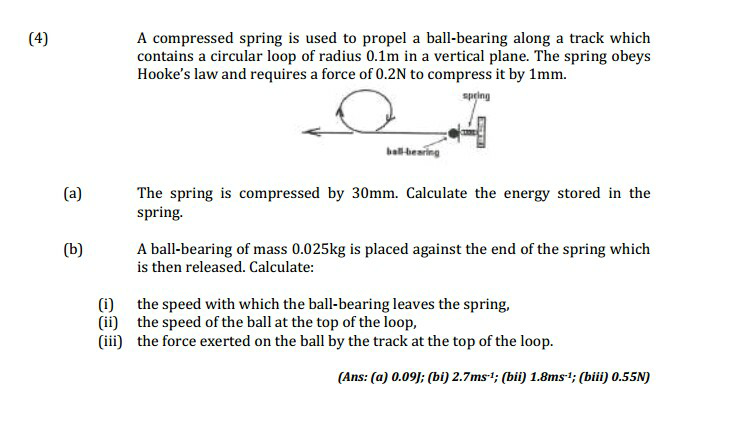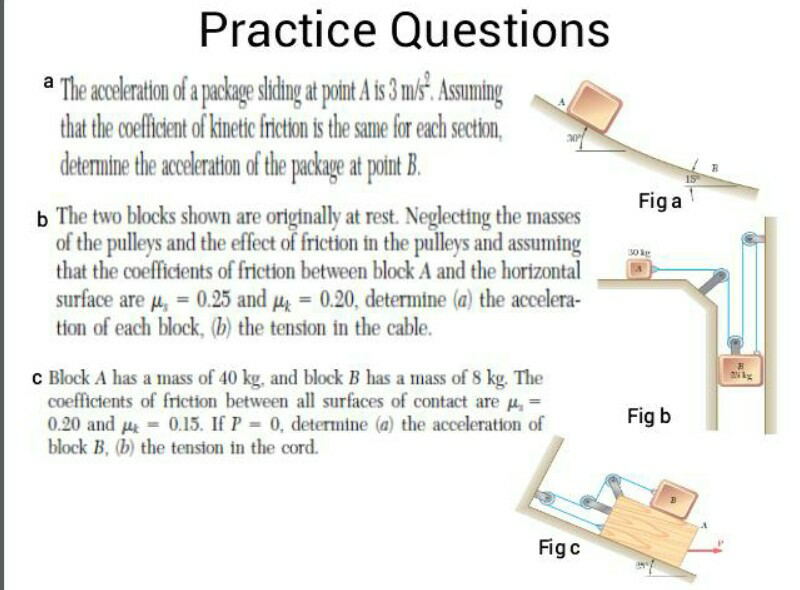
Question and Answers Forum
OthersQuestion and Answers: Page 141




Pg 136 Pg 137 Pg 138 Pg 139 Pg 140 Pg 141 Pg 142 Pg 143 Pg 144 Pg 145
|
Question and Answers Forum |
OthersQuestion and Answers: Page 141 |
| solve the simultaenous equation x+y=3 (2^x /x)=(2^y /y) find xand y.show ur workings.... |
| Two particles A and B move with constant velocities v_1 and v_2 along two mutually perpendicular straight lines towards the intersection point O. At moment t = 0, the particles were located at distances d_1 and d_2 from O respectively. Find the time, when they are nearest and also this shortest distance. |
| In dealing with motion of projectile in air, we ignore effect of air resistance on motion. What would the trajectory look like if air resistance is included? Sketch such a trajectory and explain why you have drawn it that way. |
| The horizontal range of a projectile is R and the maximum height attained by it is H. A strong wind now begins to blow in the direction of horizontal motion of projectile, giving it a constant horizontal acceleration equal to g. Under the same conditions of projection, the new range will be (g = acceleration due to gravity) [Answer: R + 4H] |

|

|
| A ball is dropped vertically from a height d above the ground. It hits the ground and bounces up vertically to a height (d/2). Neglecting subsequent motion and air resistance its velocity V varies with height h above the ground is |
| A body is at rest at x = 0. At t = 0, it starts moving in the positive x-direction with a constant acceleration. At the same instant another body passes through x = 0 moving in the positive x-direction with a constant speed. The position of the first body is given by x_1 (t) after time ′t′ and that of the second body by x_2 (t) after the same time interval. Which of the following graphs correctly describes (x_1 − x_2 ) as a function of time ′t′? |
| Solve for x, y, z (√x) + (√y) + (√z) = 4 x^2 + y^2 + z^2 = 40.125 e^(xyz) = 4.771 |
| Consider a rubber ball freely falling from a height h = 4.9 m onto a horizontal elastic plate. Assume that the duration of collision is negligible and the collision with the plate is totally elastic. Then the velocity as a function of time and the height as function of time will be |
| A ball is thrown up in a lift with a velocity u relative to the lift. If it returns to the lift in time t, then acceleration of the lift is [Answer: ((2u − gt)/t) upwards] |
| A body moves in a straight line with a velocity whose square decreases linearly with displacement between two points A and B as shown. Determine the acceleration of the particle. [Answer: (8/3) ms^(−2) ] |
| A train 1 moves from east to west (clockwise) and another train 2 moves from west to east (anticlockwise) on the equator with equal speeds relative to ground. The ratio of their centripetal acceleration (a_1 /a_2 ) relative to centre of earth is (1) > 1 (2) < 1 |
| What is the maximum magnitude of change in velocity of a motorcycle moving with a uniform speed v_0 in a circular path of length l = (π/3)R and radius R? Treat motorcycle as a particle (1) ∣Δv^→ ∣ = (v_0 /2) (2) ∣Δv^→ ∣ = v_0 |
| An object moves in a circular path with a constant speed in the xy plane with the centre at the origin. When the object is at x = −2 m, its velocity is −(4 m/s)j^∧ . Then objects velocity at y = 2 m is (1) 4 m/s i^∧ (2) (−4 m/s) i^∧ Using this data, find objects acceleration when it is at y = 2 m (1) 8 m/s^2 i^∧ (2) −8 m/s^2 j^∧ |
| A particle is moving in parabolic path x^2 = y, with constant speed u. Find the acceleration of the particle when it crossess origin. Also find the radius of curvature at origin. |
| Men are running in a line along a road with velocity 9 km/hr behind one another at equal distances of 20 m. Cyclists are also riding along the same line in the same direction at 18 km/hr at equal intervals of 30 m. The speed with which an observer must travel along the road in opposite direction of so that whenever he meets a runner he also meets a cyclist is (1) 9 km/h (2) 12 km/h (3) 18 km/h (4) 6 km/h |
| Two particles are revolving on two coplanar circles with constant angular velocities ω_1 and ω_2 respectively. Their time periods are T_1 and T_2 then prove that the time taken by second particle to complete one revolution more than the first particle, T, is given by T = ((T_1 T_2 )/(T_1 − T_2 )) |

|
| The speed of a projectile when it is at its greatest height is (√(2/5)) times its speed at half the maximum height. What is its angle of projection? |

|
| A plane moves in windy weather due east while the pilot points the plane somewhat south of east. The wind is blowing at 50 km/hr directed 30° east of north, while the plane moves at 200 km/hr relative to the wind. What is the velocity of the plane relative to the ground and what is the direction in which the pilot points the plane? |
| The unemployment rate among workers under 25 in a state went from 8.2% to 7.5% in one year. Assume an average of 1340200 workers and estimate the decrease in the number unemployed. |
| A particle starts from the origin with velocity (√(44)) ms^(−1) on a straight horizontal road. Its acceleration varies with displacement as shown. The velocity of the particle as it passes through the position x = 0.2 km is [Answer: 18 ms^(−1) ] |
| A body in a uniform horizontal circular motion possesses a variable velocity. Does it mean that the K.E. of the body is also variable? |
| A body of mass m is projected with a speed v making an angle θ with the vertical. What is the change in momentum of the body along the Y- axis; between the starting point and the highest point of its path? |
Pg 136 Pg 137 Pg 138 Pg 139 Pg 140 Pg 141 Pg 142 Pg 143 Pg 144 Pg 145 |